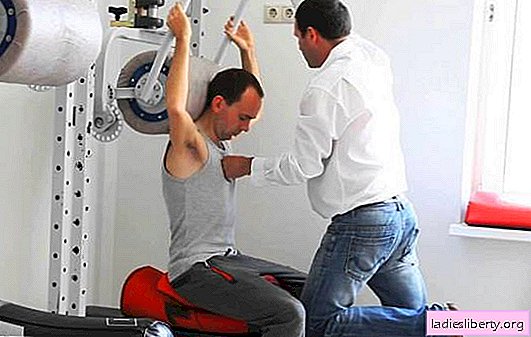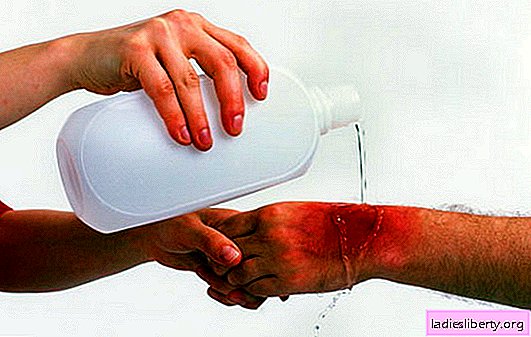
Ankylosing spondylitis is a complex rheumatic pathology, in which the patient has systemic inflammation of the joints, ossification of the ligaments and the formation of bone formations on the joint capsules of different thicknesses. Unfortunately, such a disease usually proceeds in a chronic form, constantly progressing.
Consider in more detail the symptoms and manifestations of ankylosing spondylitis in men, as well as methods of treating this ailment.
Ankylosing spondylitis in men: causes
There is no exact reason for the development of this pathology. Scientists put forward the following possible theories of ankylosing spondylitis:
1. The genetic predisposition of a person to this disease.
2. Infectious damage to salmonella or other dangerous bacteria.
In most cases, such a disease is diagnosed in men under the age of forty. In this case, chronic inflammation in the joints will lead to the fact that the patient can no longer be fully physically active. Thus, he develops a condition called ankylosis or spondylitis.
Ankylosing spondylitis in men: symptoms and signs
Most often, this disease affects the spine and large joints of a person. It can also partially affect the internal organs of the patient (heart, eyes, kidneys).
With damage to the spine, the following manifestations are observed:
1. A person begins to constantly worry about soreness in the back, most often at night. When taking analgesics, the pain is partially eliminated.
2. In the morning, stiffness in the back area will be noticeable.
3. It will be difficult for a person to move, bend down and even touch his sternum with his chin.
4. Gradually deformity of the spine develops.
5. Soreness at the entrance due to damage to the ribs that are attached to the spine.
If the disease affects the sacral zone, then the person will have the following symptoms:
1. Aching pain in the buttocks, which will give to the hips.
2. Discomfort when walking, which subsides in a sitting position.
3. In the morning, stiffness may be observed in the lower back.
With damage to the tendons, as well as ligaments, the inflammatory process can occur in the area of the heels or spine. In this state, a person will observe the following manifestations:
1. Swelling.
2. Pain during movement.
3. Hardening of ligaments in affected joints.
4. Stiffness at the lesion site.
Quite rarely, ankylosing spondylitis affects the eyes of a person. In this case, only one eye usually suffers. In this state, inflammation occurs in the structure of this organ. The patient may feel pain, decreased vision, frequent lacrimation and a sensation of a foreign object in the eye.
With the localization of inflammation in the cardiovascular system, the patient may experience:
1. Inflammation of the valves of the heart muscle.
2. The development of severe defects.
3. The appearance of arrhythmias and tachycardia.
4. Inflammation of the aorta and its further thickening.
With severe damage to the spine in a person, the nervous system may be affected in the future. This is due to the fact that changes in the spine will lead to compression of the nerve joints. In this case, a person may experience the following symptoms:
1. Nausea.
2. Dizziness.
3. Attacks of migraine.
4. When compressing nerves in the lumbar region, the patient may develop urinary incontinence and impotence.
With inflammation in the kidneys, the patient may experience urolithiasis, severe pain, as well as the deposition of protein in the kidneys, which provokes their failure.
With the defeat of large joints (hip, shoulder, knee, ankle), a person may experience the following symptoms:
1. Inflammation, which is accompanied by pain.
2. The affected joint may increase in volume.
3. Gradually develops stiffness in the joint. A person can no longer move it normally and walk (with damage to the knee or hip joint).
It is also worth noting that usually the disease affects up to three joints at a time. In this case, the elbow, carpal and other small joints do not suffer as often as large ones.
Ankylosing spondylitis in men: diagnosis and treatment
When the first signs of such a disease appear, you should immediately contact a rheumatologist. To identify ankylosing spondylitis, the patient should undergo the following diagnostic procedures:
1. History taking.
2. Examination of a diseased joint by a doctor.
3. Radiography of the spine, as well as other affected joints.
4. Ultrasound of the affected organs.
5. General blood tests to identify the inflammatory process.
Based on their research results, the doctor will establish a diagnosis. Further treatment will be selected based on the localization of inflammation, the general neglect of the pathology and symptoms in the patient.
Traditional therapy involves the following:
1. The appointment of non-selective anti-inflammatory drugs. One of the best drugs in this treatment group is Diclofenac. As a rule, it is used in tablet form (dosage of 50 mg). You need to take it three times a day. The duration of treatment is determined individually by the attending physician. Less often, Ibuprofen, Ketoprofen or Indomethacin are prescribed to the patient instead of Diclofenac.
2. Analgesics are used for severe pain. Non-narcotic pain medications are usually prescribed.
3. At elevated temperatures, antipyretic drugs may be prescribed.
4. Selective anti-inflammatory drugs. The best of these are: Nimesulide, Nimesil, Meloxicam. When taking such medications, it is important to monitor the condition of the patient’s liver, as they can affect it. Also, these drugs can cause other side effects in the form of nausea, headache and impaired appetite.
5. Glucocorticosteroids are used in severe forms of the disease. They help reduce inflammation, pain and the general condition of the affected joints. Usually, methylprednisolone is prescribed.
In addition to drug therapy, treatment also includes physiotherapy. It provides such:
1. The patient must undergo a course of physiotherapy exercises. It is selected for each patient separately, depending on the neglect of his illness. Attend this gymnastics twice a week. Its duration should be thirty minutes.
Also, during periods of remission of the disease, patients can swim and practice skiing.
2. Physiotherapeutic treatment involves ultrasound, currents, paraffin therapy and reflexology. These procedures are aimed at extending the period of remission.
During the treatment of the acute form of ankylosing spondylitis, the patient must adhere to the following doctor's recommendations:
1. Refuse from heavy physical exertion, weight lifting and sudden movements.
2. Quit smoking and drinking alcohol, as they will further affect inflammation.
3. You should sleep on an orthopedic mattress. Preferably without a pillow at all.
4. Balanced nutrition to strengthen immunity. At the same time, it is recommended to consume fermented milk products, cereals and vegetables more. Meat and fish also need to be eaten, but only in low-fat varieties and in boiled form. It is also very important to drink plenty of fluids so that the body can more easily cope with inflammation.
Ankylosing spondylitis in men: treatment, complications and prevention
When conducting modern treatment, you need to know that current treatment methods are not perfect. Of course, they can slow down the inflammation and the process of joint destruction, however, they are not able to completely rid a person of the disease.
For this reason, unfortunately, with a severe form of ankylosing spondylitis, most patients become disabled or completely lose the mobility of the diseased joint. A particularly unfavorable prognosis for the defeat of several joints at once at a fairly young age of the patient.
The main rules for the prevention of this pathology include the following:
1. Sleep on a low pillow, preferably orthopedic.
2. Active lifestyle (swimming, massage, gymnastics).
3. Sitting in a comfortable working chair.
4. Refusal of heavy physical exertion.
5. Proper nutrition, which will include the use of foods with calcium.
6. Refusal to lift weights.











